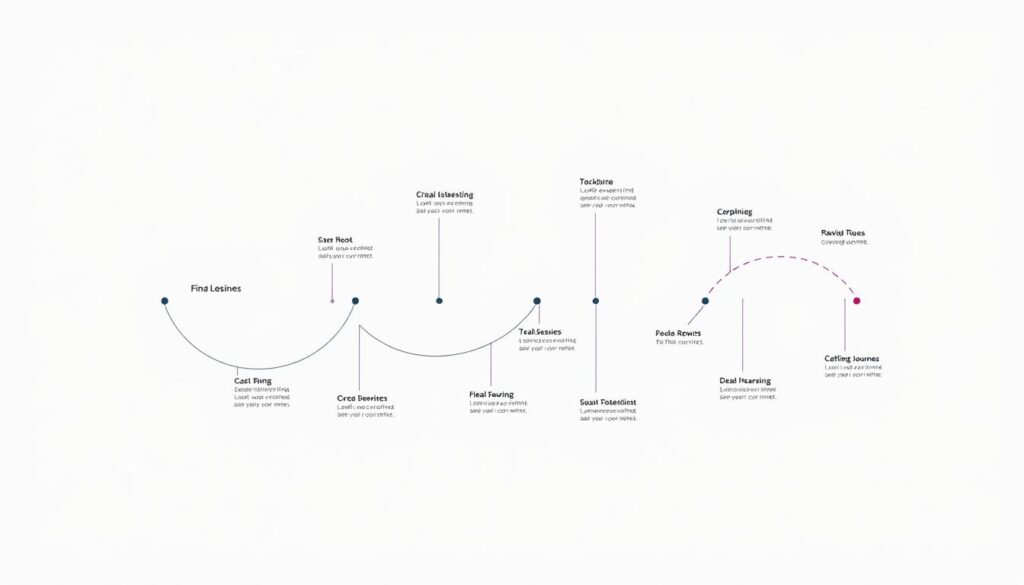What Enterprise Companies Know About Marketing That Local Businesses Don’t
73% of small businesses worldwide aren’t confident their current marketing strategy works. You’re putting in time, money, and effort into campaigns, but the results are unclear. On the other hand, big companies keep growing and engaging customers.
The difference between enterprise marketing success and local business struggles isn’t just about money. It’s about the corporate marketing approach that relies on data and systematic action. Fortune 500 companies don’t just guess—they test, measure, and improve all the time.
You can close this knowledge gap. The enterprise marketing tactics that lead to Fortune 500 success aren’t just for huge companies. They are proven strategies based on smart planning, not just spending a lot.
This guide shows what makes some businesses thrive while others struggle. You’ll learn strategies that turn uncertainty into lasting growth, no matter your company’s size.
Key Takeaways
- Nearly three-quarters of small businesses lack confidence in their current promotional efforts, creating a massive opportunity for those who adopt proven corporate methods
- Budget size doesn’t determine success—strategic thinking and data-informed decision-making create the real competitive advantages
- Large corporations succeed through systematic testing, measurement, and continuous optimization, not guesswork
- Small businesses can use the same methods as Fortune 500 companies without needing a lot of money
- The knowledge gap between corporate and local business practices is the main barrier to lasting revenue growth
- Understanding and applying proven frameworks can turn marketing uncertainty into clear, predictable results
1. Data-Driven Decision Making Over Gut Instinct
Thriving businesses know the secret to success: measuring what matters. Unlike local businesses that rely on intuition, big companies use detailed analytics. They see exactly where their money goes and what it brings back.
This shift from instinct to data isn’t just for the big players. It’s what sets sustainable growth apart from costly mistakes.
Why Enterprises Rely on Marketing Analytics Instead of Assumptions
Big marketing teams ditched assumptions long ago. They found out that gut feelings can lead to expensive mistakes. Data-driven marketing decisions cut through biases and uncover hidden opportunities.
Analytics show customer behavior that goes against common sense. You might think email is best, but data shows text messages work better. Or, you might believe social media is key, but organic search brings in customers who spend more.
Pete Kleinjan from Tiger29 says: good digital marketing strategies are backed by mountains of data. He stresses tracking important metrics like click-through-rate and website traffic. These numbers paint a real picture of how your marketing performs.
Big companies build their marketing on solid analytics. They test, measure, and adjust based on data. This turns marketing into a reliable source of income.
Key Metrics That Separate Successful from Struggling Businesses
Not all numbers are created equal. Successful businesses focus on metrics that boost revenue and profit. Struggling companies chase numbers that look good but don’t help the bottom line.
The most important marketing ROI metrics measure how well you acquire customers and their long-term value. Together, they show if your marketing investments pay off or just waste money.
Tracking Customer Acquisition Cost and Lifetime Value
Customer Acquisition Cost (CAC) shows how much you spend to win a customer. It includes all marketing and sales costs divided by the number of customers gained. If you spent $5,000 on marketing last month and got 50 customers, your CAC is $100.
But CAC only tells part of the story. You also need to look at Customer Lifetime Value (LTV). LTV is the total revenue a customer brings in over their lifetime. This comparison shows if your customer acquisition strategy is financially sound.
The formula for LTV varies by business model. A simple version is: Average Purchase Value × Purchase Frequency × Customer Lifespan. For a coffee shop, if customers spend $6 per visit, visit twice weekly, and stay loyal for two years, the LTV is $1,248.
Big companies aim for an LTV to CAC ratio of at least 3:1. This means they want to make three dollars in customer lifetime value for every dollar spent on getting them. A ratio below this suggests your marketing costs too much of your profit.
Understanding Multi-Touch Attribution Models
Most small businesses give all credit to the last touchpoint before a purchase. This oversimplifies customer journeys and misallocates resources. A customer might find you on social media, research you online, read reviews, return through an ad, and convert after an email. Which touchpoint gets the credit?
Multi-touch attribution models recognize that customers interact with your brand many times before buying. They spread conversion credit across touchpoints based on their influence. Even simple multi-touch models are better than last-click approaches.
Common attribution models include:
- Linear attribution: Gives equal credit to all touchpoints in the customer journey
- Time-decay attribution: Credits interactions closer to the conversion more
- Position-based attribution: Values first and last touchpoints more, with middle interactions getting less
- Data-driven attribution: Uses machine learning to assign credit based on actual influence (requires a lot of data)
Understanding attribution helps you see the real value of channels that help conversions, even if they don’t get the final credit. Your content marketing might not get direct conversions but could educate prospects who later buy through paid search.

How Local Businesses Can Start Measuring What Actually Matters
You don’t need a big budget or a data science team to use analytics in marketing. What you need is to define success, measure it regularly, and let data guide your decisions. The main barrier is treating marketing as a measurable investment, not just an expense.
The first step is using tools that are easy to access and focus on metrics that matter to your revenue. By doing this, you build a foundation that grows with your business.
Setting Up Your First Analytics Dashboard
Google Analytics is a powerful free marketing analytics tools for small businesses. Most companies have it on their websites but don’t use it fully. Your first task is to set it up to track actions that bring in revenue.
Pete Kleinjan recommends setting up Key Performance Indicators (KPIs) specific to your business. These could be phone call button pushes, contact page views, or form fill inquiries. Each shows a customer moving closer to buying.
To set up conversion tracking, follow these steps:
- Identify your conversion events: List every action on your website that shows buying intent or generates revenue
- Configure goals in Google Analytics: Go to Admin > Goals and create a new goal for each conversion event, specifying the URL or event that triggers completion
- Assign monetary values: Estimate the dollar value of each conversion type based on your close rate and average sale amount
Once set up, your dashboard will show which sources, content, and campaigns drive valuable actions. This insight lets you focus on what works and cut what doesn’t.
Three Essential Metrics to Track Starting Today
Instead of getting lost in many metrics, successful businesses focus on a few key ones. These three metrics are the foundation for data-driven marketing decisions without overwhelming analysis.
Conversion Rate by Traffic Source: This metric shows which channels bring visitors most likely to take valuable actions. Calculate it by dividing conversions from each source by total visitors from that source. You might find that social media brings lots of traffic but converts poorly, while email subscribers convert better.
Revenue per Channel: Track the actual revenue each marketing channel brings in. Some channels might convert less but attract higher-value customers. Multiply conversions by average transaction value for each source to find your most profitable channels. This marketing ROI metrics approach ensures you optimize for profit, not just conversion volume.
Engagement Metrics for Content: Watch which content keeps visitors engaged versus those that lead to quick exits. Track average time on page, scroll depth, and bounce rate for your key content. High engagement means your content educates and builds trust, even if it doesn’t convert immediately. These pieces are key in multi-touch customer journeys.
The table below compares these essential metrics with their targets and action triggers:
| Metric | How to Calculate | Healthy Target | Action If Below Target |
|---|---|---|---|
| Conversion Rate by Source | Conversions ÷ Total Visitors × 100 | 2-5% for most industries | Review landing page relevance and user experience for underperforming sources |
| Revenue per Channel | Total Revenue from Source ÷ Marketing Cost | 3:1 return minimum | Reduce spend on unprofitable channels; increase budget for high performers |
| Content Engagement Rate | Visitors reading 50%+ ÷ Total Visitors | 40-60% engagement | Improve content relevance, format, or targeting to increase engagement |
| Customer Acquisition Cost | Total Marketing Spend ÷ New Customers | Less than 33% of LTV | Optimize conversion funnel or improve targeting to reduce waste |
These metrics work together to show how well your marketing works. High traffic with low conversions means targeting or messaging issues. High conversions with low engagement means you’re attracting the right audience but might be leaving more value on the table by not nurturing relationships.
Switching from gut feelings to data-driven marketing takes time. Start by tracking these key metrics, review them weekly, and let the data guide your next steps. This discipline separates businesses that grow predictably from those that struggle to understand why marketing sometimes works and sometimes doesn’t.
2. Building a Unified Customer Journey Instead of Isolated Campaigns
Big companies know something small businesses often miss. Customers don’t see your marketing as separate pieces. They see it as one journey. When you run a Facebook ad, an email, and a website update, it’s like separate projects to you. But to customers, it’s all part of their experience with your brand.
This gap causes confusion and lost chances. A customer might click your ad but find a generic homepage. They might get an email that doesn’t match the ad they saw. Each step feels like starting over, not moving forward.
Big companies focus on customer journey mapping because it works. Marketing agencies like Omnius use a holistic approach. They blend technical SEO with creative content for lasting results. This way, every touchpoint supports the last one, not competing with it.
This approach is more than just a philosophy. It’s profitable. When you treat marketing as a unified experience, you reduce confusion. You build trust and guide customers from awareness to advocacy.
How Enterprises Map the Complete Customer Lifecycle
Marketing teams in big companies don’t guess about customer journeys. They document them carefully. They map out where customers start, what they ask, and what influences their decisions.
This mapping goes beyond simple sales funnels. Sophisticated marketers create detailed journey maps that include emotional states and information needs. They understand why customers move forward and what they need to feel confident.
The process starts with research, not guesses. Big companies interview customers and analyze data from websites and CRM systems. They track how long customers spend in each stage and what content helps them move forward.
“Companies that excel at customer journey mapping generate 54% greater return on marketing investment than those that don’t, because they eliminate waste and focus resources where they create actual value.”
This research gives insights that boost marketing effectiveness. You find out certain blog posts lead to higher conversions. You identify common objections and recognize valuable customers.
The mapping process creates a visual guide for the customer lifecycle. This becomes your strategy for marketing activities. Instead of asking what campaign to run next, you ask what customers need at each stage.
LYFE Marketing focuses on building customer journeys that turn leads into loyal clients. Their approach shows how journey mapping leads to practical marketing that gets results.
Connecting Awareness, Consideration, Purchase, and Retention Stages
The customer lifecycle has four key stages that need different marketing approaches. Understanding how to connect these stages is key for marketing funnel optimization and growth.
Awareness is when people first learn about solutions like yours. They’re identifying problems or opportunities. Your marketing should educate, not sell, building recognition and expertise.
Consideration starts when prospects evaluate options. They compare approaches and research providers. Your marketing should show how you differ, provide proof, and address concerns.
Purchase is when consideration turns into commitment. Your marketing should remove obstacles, reinforce the decision, and ensure smooth transactions. Clear calls-to-action and transparent pricing reduce abandonment.
Retention begins after purchase and determines long-term value. Post-purchase marketing focuses on onboarding, satisfaction, repeat purchases, and advocacy. Maximizing customer lifetime value is key to profitability.
The real power comes from designing connections between these stages. Each phase should naturally lead to the next, with marketing that acknowledges where customers are and prepares them for where they’re going.

The weakest point in most marketing systems is the transition between touchpoints. A prospect might click your ad but find a generic page. They might download your guide but get unrelated emails. Each disconnection erodes trust and increases abandonment.
Big companies engineer seamless transitions by ensuring message continuity. If someone clicks an ad about solving cash flow problems, they land on a page addressing those solutions. The content acknowledges their interest and guides them to the next step.
This customer journey strategy goes beyond initial clicks. Email sequences reference previous interactions. Retargeting ads acknowledge what prospects have seen. Sales conversations build on what customers have consumed, not starting from scratch.
Creating these seamless transitions requires systematic planning. You map the intended path from each entry point through conversion, identifying every touchpoint. Then you design each element to acknowledge the previous interaction and set up the next one, creating a cohesive narrative.
Aligning Messages Across Different Channels
Customers interact with your brand across various marketing channels. When messages contradict or compete, you create confusion, not conversion.
Omnichannel marketing strategy ensures every channel reinforces consistent themes and value propositions. This doesn’t mean saying the same thing everywhere. It means adapting core messages for each channel while maintaining strategic consistency.
Your social media might focus on community and engagement, while your email marketing educates and delivers value. These different approaches should support the same strategic positioning and guide prospects toward the same goals.
Message alignment requires documented brand guidelines and marketing themes. Enterprises create messaging frameworks that define core value propositions and key differentiators. Every channel adapts these frameworks to their specific context while maintaining consistency that builds recognition and trust.
| Marketing Channel | Primary Purpose | Message Focus | Typical Journey Stage |
|---|---|---|---|
| Social Media | Awareness & Engagement | Problem identification, brand personality | Awareness to Early Consideration |
| Content Marketing | Education & Authority | Solution education, expertise demonstration | Consideration |
| Email Marketing | Nurturing & Conversion | Relationship building, objection handling | Consideration to Purchase |
| Website/Landing Pages | Information & Conversion | Specific solutions, proof points, CTAs | All Stages |
| Retargeting Ads | Re-engagement & Conversion | Specific offers, urgency, reminders | Late Consideration to Purchase |
Step-by-Step Guide to Implementing Journey Mapping for Small Businesses
You don’t need a big budget or team to start customer journey mapping. The framework works for any business size by focusing on the basics and building step by step. Here’s how to create your first journey map and connect your marketing touchpoints.
Step 1: Define Your Primary Customer Personas
Start by documenting who your ideal customers are. Create 2-3 detailed personas for your most valuable customer segments. Include their goals, challenges, decision-making criteria, and information sources. This foundation ensures your journey map reflects actual customer needs.
Step 2: Document the Current Path from Discovery to Purchase
Map how customers currently move through your buying process. Interview recent customers to understand their journey. What prompted them to start looking? Where did they first find you? What information did they need? What almost stopped them from buying? This research reveals the real customer experience, not your intended one.
Step 3: Identify Key Stages and Decision Points
Break the journey into distinct stages based on your research. For most businesses, this includes awareness, research, evaluation, decision, and post-purchase. Identify the critical decision points where customers choose to move forward or drop out.
Step 4: Map Current Marketing Touchpoints to Each Stage
List every marketing touchpoint customers might encounter—your website, social media, ads, content, emails, sales conversations. Then map each touchpoint to the journey stages where they currently operate. This reveals gaps where customers need support but aren’t receiving it, and overlaps where you’re providing redundant information.
Step 5: Identify Gaps, Friction Points, and Opportunities
Analyze your current journey map to find problems and opportunities. Look for stages where customers get stuck or abandon the process. Identify transition points where messaging doesn’t connect. Find questions that customers have but you’re not answering. These gaps become your strategic priorities for improvement.
Step 6: Design Connected Marketing Activities for Each Stage
Create or refine marketing activities that address customer needs at each journey stage. Ensure each activity acknowledges where customers are coming from and prepares them for the next stage. Build intentional transitions that reduce friction and maintain momentum through the buying process.
This systematic approach to customer journey mapping transforms scattered marketing tactics into strategic customer experiences. You’ll make decisions based on where activities fit in the customer lifecycle, not chasing trends.
Implementation doesn’t require perfection from day one. Start with a basic journey map and refine it as you gather more data. Test different approaches at key transition points and measure what improves progression rates. The goal isn’t creating a complex diagram—it’s building marketing systems that guide customers naturally from awareness to advocacy.
When you shift from isolated campaigns to unified customer journeys, you’ll notice several immediate benefits. Your marketing messages become more relevant because they address specific journey stages. Your conversion rates improve because you’re reducing friction at critical decision points. Your customer relationships strengthen because every interaction builds on previous ones, not starting from scratch.
The investment in journey mapping pays dividends across your entire marketing ecosystem, creating the foundation for sustainable growth that compounds over time.
3. Enterprise Marketing Strategy: Investing in Brand Building, Not Just Direct Response
Big companies know a secret that small businesses often miss. The customers who cost the least to get tomorrow are influenced by today’s brand investments. While small businesses focus on quick results, big companies spend a lot on building their brand over time. This difference helps big companies stay ahead.
It’s not about having more money. It’s about knowing how to use marketing money wisely over time. This creates lasting advantages.
Pete Kleinjan says if your business looks like everyone else’s, customers treat you like a commodity. Branding is more than a logo. It’s the feeling people get when they see your name or visit your website. Without a unique brand, you compete only on price, hurting your profits with every sale.
The 60/40 Rule for Balancing Brand and Performance Marketing
Studies show big companies spend about 60% on building their brand and 40% on direct marketing. This ratio is based on years of testing. It shows how brand and direct marketing work together, not against each other.
Brand-building includes content, social media, PR, and sponsorships. These don’t bring quick sales but make your business more visible. They help customers think of you when they need what you offer.
Performance marketing includes ads, emails, and social ads. These bring quick results. Big companies know that strong brands make these tactics more effective over time.
When customers trust your brand, your ads work better. You spend less on ads, get more sales, and keep customers longer. A good marketing strategy uses both brand and direct marketing.

The 60/40 rule is a good start, but adjust it for your business. New businesses might start with 70-80% on direct marketing. But staying only in direct marketing is a dead-end.
Why Short-Term ROI Thinking Limits Long-Term Growth
Many small businesses want quick, measurable results from every dollar. This feels smart but is risky. It limits your business’s growth.
Focus on direct marketing makes customers price-sensitive. They wait for sales instead of valuing what makes you unique. This makes you seem interchangeable with others.
Short-term focus also makes you vulnerable to cheaper competitors. Without a strong brand, you can’t charge more. This leads to thin margins and low profits.
Direct marketing costs go up over time. Your customer acquisition costs rise, but you can’t stand out as much. This cycle makes it hard to keep growing.
A good marketing strategy balances short-term and long-term goals. Building a strong brand is key. It leads to higher margins, loyal customers, and resilience against competition.
Marketing agencies like NinjaPromo help with branding. They improve visibility, PR, and trust. These efforts pay off for years, beating short-term tactics.
How to Create Brand Equity on a Local Business Budget
You don’t need a big budget to build a strong brand. Focus on consistent brand-building to stand out. Treat it as a key business function, not a luxury.
Start by defining your brand clearly. Pete Kleinjan says to make your brand clear so platforms know who you are. This consistency builds trust across all touchpoints.
Focus on visual and messaging standards and a unique value proposition. This differentiates you from competitors.
Building Consistent Visual and Messaging Standards
Visual consistency builds trust and credibility. You don’t need expensive designers. Just apply clear standards everywhere customers see you.
Set guidelines for your brand elements:
- Logo usage: Define how your logo appears, including sizes and colors
- Color palette: Choose colors and use them consistently
- Typography: Pick specific fonts for all materials
- Imagery style: Define the style of your photos or graphics
- Voice and tone: Establish your communication style
Keep these standards in a simple guide. Consistency across many interactions shows professionalism and reliability.
Developing Your Unique Value Proposition
Your unique value proposition explains why customers should choose you. It’s not just different, but better. This is the core reason customers prefer you over others.
Good value propositions combine three things:
- What you do exceptionally well: Identify your strengths
- What your customers value most: Understand what drives their decisions
- What competitors can’t easily replicate: Find unique advantages
Businesses that charge more clearly communicate their value. Instead of saying you offer quality service, explain the specific benefits customers get from you.
This clarity makes your marketing more compelling. It attracts the right customers and keeps the wrong ones away. You stop competing on price and win based on value.
| Marketing Approach | Brand-Building Focus | Performance-Only Focus |
|---|---|---|
| Primary Goal | Create lasting customer relationships and market differentiation | Generate immediate sales and measurable conversions |
| Time Horizon | Long-term investment with compounding returns over months and years | Short-term results measured in days or weeks |
| Customer Relationship | Value-based loyalty with premium pricing acceptance | Price-sensitive transactions with limited differentiation |
| Competitive Position | Distinctive positioning protected from price competition | Commodity status vulnerable to competitors with lower prices |
| Measurement Approach | Brand awareness, consideration, preference, and customer lifetime value | Cost per acquisition, conversion rate, immediate return on ad spend |
The best businesses see brand and direct marketing as partners. Your brand makes your direct marketing more effective. Your direct marketing funds your brand. This cycle fuels sustainable growth that direct marketing alone can’t achieve.
4. Leveraging Marketing Technology and Automation at Scale
The right marketing technology changes how businesses work. It cuts down on repetitive tasks and makes customer engagement better. You don’t need a big budget to get tools that boost your work. The key is to pick technology wisely, not just for the sake of newness.
Marketing agencies like WebFX show how to use email campaigns and ad tools well. Ignite Digital manages social media and schedules posts across platforms. These tools aren’t just for big companies; they’re for businesses ready to work smarter.
The MarTech Stack That Powers Enterprise-Level Results
A MarTech stack is a set of marketing tools used to plan, execute, and measure marketing. Big companies don’t just pick tools randomly. They build a system where each tool works well together and shares data easily.
Think of your MarTech stack like a kitchen. You wouldn’t buy every gadget, but you’d make sure your essential tools work well together. Marketing technology works the same way.
The best stacks have a few key parts:
- Customer relationship management systems that keep all customer data in one place
- Marketing automation platforms that send personalized content based on what customers do
- Analytics tools that track how well marketing is doing
- Content management systems that make publishing easier
- Social media management platforms that help manage your online presence
Customer Relationship Management systems are like your marketing headquarters. They track every interaction a customer has with your business. This lets you send personalized messages that really speak to the customer.
Marketing automation platforms take CRM to the next level. They do things automatically based on what customers do. For example, if someone downloads your guide, they get emails that match their interests. If they leave something in their cart, they get reminders without you having to do anything.
This CRM integration makes customers feel understood. It’s like you’re nurturing a relationship, but you’re doing it in a way that’s systematic. This lets your team focus on things that really matter, like coming up with new ideas and creating content.
Email Marketing Tools and Customer Data Platforms
Email is a top marketing channel when used right. Today’s email tools do more than just send out newsletters. They can segment your audience, personalize messages, and test different versions automatically.
Customer Data Platforms (CDPs) bring together data from all over to create a complete picture of your customers. They connect website visits, purchases, email interactions, social media, and even offline interactions. This lets you send messages that are really tailored to each customer.
Big companies use CDPs to answer big questions. Like, who’s most likely to buy next? Who might leave? What content do different groups like? These answers help turn generic campaigns into something that really speaks to people.
Affordable Automation Tools Accessible to Local Businesses
You don’t need to spend a lot to get great marketing tools. The world of marketing technology has changed a lot, making top tools more affordable.
Here are some budget-friendly options that pack a punch:
- HubSpot CRM (Free) – Offers contact management, email tracking, and basic automation without monthly fees
- Mailchimp – Sends email sequences, segments your audience, and creates landing pages for under $20 a month
- Buffer or Hootsuite – Schedules social media posts across platforms for less than hiring more staff
- Google Analytics (Free) – Gives insights into your website that help you make better content and campaigns
- Canva – Creates professional graphics without needing design skills or expensive software
These tools cost less than taking your team out for lunch every week. But they can really boost your reach and effectiveness. The key is to pick tools that solve real problems, not just for the sake of having new technology.
Start with one tool that solves a big problem for you. Get really good at it before adding more. This way, you avoid wasting money on tools you don’t use much.
How to Build Processes Before Adding Technology
Most businesses fail because they think new technology will fix all their problems. It won’t. Technology amplifies existing processes—if your workflows are a mess, automation just makes things worse faster.
Big companies plan out their workflows carefully before adding new tools. They figure out where things get slow, what’s hard to do, and what they want to achieve. This makes sure the technology they add really helps, not just adds more complexity.
Follow this process-first approach:
- Document your current workflow – Write down every step in processes like lead follow-up or content creation
- Identify pain points – Where do tasks get delayed? What requires too much manual work?
- Define desired outcomes – What would success look like? Faster response times? Better personalization?
- Research solutions – Which tools address your specific bottlenecks?
- Test with free trials – Try out platforms before committing to pay
This careful approach helps avoid wasting money and makes sure your MarTech stack really adds value, not just takes up resources.
Identifying Repetitive Tasks Worth Automating First
Not every task is worth automating. Look for things that are repetitive, time-consuming, and really important when done right. These are the best candidates for automation.
Some high-impact tasks to automate include:
- Lead follow-up sequences – Automatic emails that help move prospects through your sales process
- Welcome series – Educational content for new subscribers or customers
- Social media posting – Scheduling posts at the best times to get more engagement
- Appointment reminders – Reducing no-shows with automated confirmations and reminders
- Review requests – Asking happy customers for testimonials automatically
Calculate how much time you’ll save before automating. If a task takes 30 minutes a week and setting up automation takes 2 hours, you’ll break even in a month. After that, it’s all about getting more done with less effort.
Remember, marketing technology is not a replacement for creativity and strategy. It’s about freeing up time for more important things like building relationships, planning, and creating content. Your skills become more valuable when you’re not stuck doing the same thing over and over.
The best businesses see their CRM integration and automation tools as ways to multiply their team’s efforts. Start small, master the basics, and then add more as you grow and your needs change.
5. Creating Documented Processes and Marketing Playbooks
Local businesses often rely on memory and improvisation. But, enterprise marketers document every workflow. They create playbooks that scale expertise across entire organizations.
This systematic approach transforms individual knowledge into repeatable processes. It delivers consistent results. You can adopt this framework without needing enterprise-level resources.
The difference is clear when key team members leave or new campaigns launch. Enterprises maintain quality because their marketing process documentation preserves institutional knowledge. Local businesses often scramble to recreate lost expertise.
The Strategic Value of Documenting Marketing Processes
Enterprises invest substantial resources in documentation for reasons that directly impact profitability. When you document marketing workflows, you create organizational assets that outlive individual employees. This investment pays dividends through faster training, reduced errors, and scalable operations.
Consider what happens when your best marketer goes on vacation or accepts another position. Without documentation, their expertise disappears with them. With complete playbooks, their methods become permanent organizational capabilities.
Documentation also eliminates the mental burden of remembering procedures. Your team stops wasting cognitive energy on “How did we do this last time?” questions. Instead, they focus creative thinking on strategy and innovation while execution follows established frameworks.
Agencies like Kexino demonstrate this principle by maintaining documented site structure and SEO-friendly copywriting processes. These documented approaches ensure consistent quality regardless of which team member handles specific projects. Splurge Media ensures business stories remain clear, compelling, and consistent through established documentation standards.
How SOPs Maintain Quality Across All Marketing Activities
Standard operating procedures answer the repetitive “how” questions that consume time in undocumented organizations. They transform best practices into standard practices that everyone follows automatically.
Your standard operating procedures should address specific situations your team encounters regularly. How do you optimize blog posts for search engines? What’s the approval process for social media content? How do you respond to negative online reviews? When do leads get passed from marketing to sales?
Each documented answer eliminates repeated decisions and prevents quality variations. New team members perform at experienced levels faster because they’re following proven methods. They don’t develop approaches through trial and error.
Enterprise marketing departments typically document procedures for:
- Content creation and approval workflows
- SEO optimization checklists for different content types
- Social media posting schedules and response protocols
- Email campaign development and testing procedures
- Lead qualification and handoff criteria
- Campaign performance review processes
- Brand guidelines and messaging standards
These standard operating procedures don’t stifle creativity—they free it. When mechanical execution follows documented processes, your creative energy focuses on strategy, messaging, and innovation. You don’t waste time on basic operational questions.
Building Your Marketing Playbook Without Overwhelming Your Team
You don’t need to document everything simultaneously. Start with your highest-impact, most frequent activities. These are the processes you repeat weekly or monthly that directly influence revenue. This focused approach delivers immediate value without creating documentation fatigue.
Begin by identifying the three marketing activities that generate the most leads or revenue for your business. These become your documentation priorities. For most local businesses, this includes lead generation, content creation, and campaign launches.
Documenting Your Lead Generation and Follow-Up Process
Your lead generation documentation should map every step from initial contact through conversion. Start by listing every touchpoint in your current process, even informal ones. Where do leads first hear about you? What information do you collect? How quickly do you respond? Who handles follow-up?
Create a written procedure that ensures no lead falls through cracks. Specify response timeframes—ideally within one hour for online inquiries. Define qualification criteria that determine which leads receive immediate attention versus nurturing sequences. Document exactly what information your team collects and where it’s stored.
Your lead follow-up documentation should include message templates for common scenarios, escalation procedures when leads don’t respond, and clear handoff criteria when leads become sales-ready. This systematized approach dramatically improves conversion rates by ensuring professional, timely communication with every prospect.
Creating Content Creation and Distribution Guidelines
Content quality varies wildly in organizations without documented standards. Your content guidelines should define what “good” looks like for each content type you produce. Specify minimum word counts, required elements, SEO optimization steps, and approval workflows.
For blog content, document your keyword research process, on-page SEO requirements, internal linking standards, and formatting preferences. Include your content calendar management system and publication procedures. Define how you measure content performance and when you update or retire older pieces.
Your distribution guidelines ensure published content reaches intended audiences. Document which channels receive each content type, posting schedules, promotional budgets, and engagement response protocols. This turns content creation from unpredictable effort into a reliable system that consistently attracts and engages prospects.
Building Campaign Launch Checklists
Campaign failures often result from overlooked details. A complete launch checklist prevents these avoidable mistakes. Your checklist should verify that every campaign includes necessary components before going live.
Essential checklist items include:
- Clear campaign objectives with specific success metrics
- Defined target audience with documented characteristics
- Appropriate messaging tested with sample audience members
- Proper tracking implementation across all channels
- Budget allocation and spending limits configured
- Creative assets reviewed and approved by stakeholders
- Landing pages tested across devices and browsers
- Follow-up sequences programmed and tested
- Team members briefed on their specific responsibilities
- Post-campaign review meeting scheduled
This systematic approach prevents the “ready, fire, aim” mentality that wastes marketing budgets. Each campaign launches with strategic clarity and operational completeness.
Remember that marketing process documentation evolves as you discover better methods. Schedule quarterly reviews of your playbook to incorporate lessons learned and refine existing procedures. This continuous improvement transforms documentation from static rulebook into dynamic competitive advantage.
Start small, document thoroughly, and expand gradually. Within six months, you’ll have created organizational assets that dramatically improve marketing consistency, quality, and results—the same advantage that enterprise companies leverage to dominate their markets.
6. Testing, Learning, and Optimizing Continuously
Most local businesses start campaigns hoping for success. But big companies test their way to certainty. Marketing experimentation changes how effective marketing is, replacing guesswork with real results.
Big companies see every campaign as a chance to learn, not just win or lose. This changes how they improve and invest in marketing.
The Enterprise Approach to A/B Testing and Experimentation
Big marketing teams use a systematic method that removes opinions and ego. They design controlled experiments to see what customers prefer.
This A/B testing framework has four key steps that work for any business:
- Form hypotheses based on data – Start with specific questions to test, based on data, not guesses
- Design controlled experiments – Focus on one variable at a time to understand its impact
- Analyze results with statistical rigor – Make sure the results are real, not just random
- Scale winning variations – Use the best approaches and learn from the ones that didn’t work
Pete Kleinjan says almost every digital marketing strategy takes time to work. He suggests keeping a 6-month budget to focus on strategy and making decisions based on facts, not feelings.
Disruptive Advertising shows how to improve visitor chances to convert by testing different approaches. They turn website traffic into more sales by trying out various options.
Creating a Culture of Continuous Improvement
The biggest challenge to marketing experimentation is not technical—it’s psychological. Many business owners worry that testing will show failures or waste resources. Big companies overcome this by changing how they view unsuccessful tests.
Companies that keep improving create environments where testing that doesn’t work is valued. Why? Because getting rid of what doesn’t work helps find what does.
Overcoming the Fear of Testing and Failure
Your mindset about “failed” tests determines if you’ll experiment or avoid it. Big companies see unsuccessful tests as chances to learn, not waste resources.
Think of a test that shows a new headline decreases conversions by 15% as valuable. It saved you from using that headline everywhere. You learned what doesn’t work, which is just as valuable as knowing what does.
To overcome testing fear, celebrate learning, not just wins. Share insights from tests that didn’t do well. Talk about what the data showed about customer preferences and behavior.
Allocating Budget for Experimentation
Big marketing teams usually save 10-20% of their budget for testing new things. They see it as an investment in getting better, not a risk.
Even small businesses can follow this principle. If your monthly budget is $2,000, setting aside $200-400 for testing is a good start. It lets you try new things without risking your main business.
This dedicated testing budget lets you try new things without worrying about immediate results. You’re investing in learning what works for your audience, which improves all your future campaigns.
Setting Up Your First Testing Framework
You don’t need big resources or technical skills to start systematic testing. You just need a clear plan that focuses on important variables, not small details.
Your first A/B testing framework should have three key parts:
- Testing hypothesis documentation – Write down what you’re testing, why it matters, and what you expect
- Measurement protocols – Decide which metrics show success and how to track them
- Decision criteria – Set clear rules for when to scale, improve, or stop a test
This structure helps avoid running tests without clear goals. It prevents selectively choosing results to support your beliefs.
What to Test First for Maximum Business Impact
Not all marketing elements are created equal. Smart businesses focus on testing the most impactful areas first. Start with these high-leverage variables:
| Element to Test | Why It Matters | Expected Impact |
|---|---|---|
| Headlines and opening hooks | Determines whether people engage with your content at all | Can improve engagement rates by 20-50% |
| Call-to-action buttons | Directly influences whether visitors take desired actions | Can increase conversion rates by 15-30% |
| Landing page layouts | Affects trust, clarity, and visitor decision-making process | Can improve conversion rates by 25-100% |
| Email subject lines | Controls whether messages get opened and read | Can increase open rates by 10-40% |
Start with the element that directly impacts your most important business goal. If you need more leads, test landing page headlines and forms. If you struggle with email engagement, focus on subject line variations and opening paragraphs.
How to Analyze Results and Scale Winning Variations
Running tests is easy, but understanding the results is harder. Many businesses make scaling decisions based on early trends, not solid data. This can lead to implementing changes that don’t improve performance.
Your analysis should answer three key questions before declaring a test winner:
- Did you reach minimum sample size? – Small sample sizes produce unreliable results that don’t represent true performance patterns
- Is the difference statistically significant? – Performance variations might result from random chance, not actual superiority
- Does the winning variation align with other data? – Confirm that test results match broader patterns in your analytics
Most A/B testing tools include statistical significance calculators. These tools tell you when you have enough data to make confident decisions. Usually, you need at least 100 conversions per variation and 95% statistical confidence before scaling a winning approach.
When you find a genuine winner, implement it right away and document what you learned. Then, design your next test to build on this insight. This systematic approach to marketing experimentation compounds improvements over time, giving you an edge over competitors.
Remember, optimization is an ongoing practice. Markets change, customer preferences evolve, and new opportunities emerge. Businesses that keep testing and learning consistently outperform those that stop experimenting once they find something that works.
7. Building Marketing Teams with Specialized Roles and Expertise
Business success often depends on how well a company structures its marketing team. Big companies know that using generalists for marketing doesn’t lead to breakthroughs. Instead, they focus on specialized marketing roles for better results.
Maybe you’re used to one person handling everything from your website to social media. This approach works for a while but hits a ceiling. Learning from big companies can help you build a team that grows with your business.
Your marketing team’s structure today will shape your future growth. Let’s look at how to build teams that achieve big results without spending a lot.
How Enterprise Marketing Departments Are Structured for Success
Big companies don’t just throw people together in marketing. They organize teams around specific areas or customer stages. This way, each team becomes an expert in their field.
Some teams focus on content, SEO, paid ads, social media, email, and analytics. Each team masters their area, keeping up with changes and best practices.
Other teams focus on different stages of the customer journey. This ensures a smooth experience for customers as they move through your funnel.
Most big companies mix both approaches. For example, a content team might have specialists for different stages, while analytics help all teams with data.
This approach isn’t just about being big. It’s about recognizing that marketing is complex and needs focused skills. A good SEO specialist, for example, will always outperform someone who does SEO as part of many tasks.
The key for your business is to match your marketing team structure with your competitive edge. You don’t need to copy big companies, but you do need specialists in key areas for growth.
The Power of Specialization Over Jack-of-All-Trades Generalization
Pete Kleinjan says being a generalist might work at first, but it leads to burnout. Just because you can do something doesn’t mean you’re good at it. Trying to do everything takes away from growing your business.
Generalists are good for small teams because they know many channels. But specialists outperform in three key ways.
Focused practice develops superior skills. A specialist in paid ads, for example, gets better with time. This leads to better results and ROI.
Deep expertise reveals opportunities that generalists miss. An SEO specialist spots opportunities that others don’t. A content strategist finds ways to connect with audiences better.
Specialized knowledge keeps pace with rapid changes. Marketing changes fast. Specialists keep up, while generalists struggle to keep up with many areas.
Let’s compare the results of generalists versus specialists:
| Marketing Capability | Generalist Approach | Specialist Approach | Performance Gap |
|---|---|---|---|
| Paid Search Campaigns | Basic keyword targeting, standard ad copy, monthly optimization | Advanced audience segmentation, A/B tested messaging, weekly refinements | 40-60% higher conversion rate |
| Content Marketing | Generic blog posts covering basic topics without strategic focus | SEO-optimized content addressing specific buyer questions and search intent | 3-5x more organic traffic |
| Email Marketing | Batch-and-blast campaigns with standard templates and timing | Segmented campaigns with behavioral triggers and personalization | 25-35% higher open rates |
| Social Media | Inconsistent posting with promotional content and minimal engagement | Strategic content calendar with community management and platform optimization | 50-70% more engagement |
Specialists don’t just do a little better; they make a big difference. While generalists offer flexibility, specialists are more valuable as marketing gets more complex.
Strategically Scaling Your Marketing Team as You Grow
Knowing when to add specialized marketing roles is key. It separates businesses that grow well from those that waste resources or miss opportunities.
Your journey from solo marketer to team leader follows predictable stages. Recognizing these phases helps you make smart decisions about building your team.
Stage 1: Founder-Led Marketing (Revenue: $0-$500K)
At first, you might handle everything yourself. Focus on learning what works for your audience and market. This phase lays the groundwork for future hires.
Stage 2: First Marketing Hire (Revenue: $500K-$2M)
Your first hire should be a marketing generalist. They can manage multiple channels while you focus on growing the business. This person coordinates efforts and finds what works.
Stage 3: Initial Specialization (Revenue: $2M-$5M)
Add your first specialist in a key channel. For many, this means a content, paid ads, or SEO expert. Consider agencies for other channels.
Stage 4: Building Functional Teams (Revenue: $5M+)
As you grow, build teams around key channels. Your team will have specialists, clear roles, and defined goals. Scaling marketing operations means creating systems that grow with your business.
When to Hire In-House Specialists vs. Outsource to Agencies
Deciding to hire or outsource affects your marketing’s effectiveness and budget. Use strategies to choose the best approach for each skill.
Hire in-house specialists when:
- You need the skill all the time, not just for projects
- Deep knowledge of your products and customers is key
- The workload justifies a full-time or significant part-time role
- Ongoing optimization brings long-term benefits
Outsource to specialized agencies when:
- You’re testing new channels before committing
- You need expertise you can’t develop internally quickly
- Project-based work doesn’t justify ongoing costs
- Access to diverse specialists offers better value
Marketing agencies can be a game-changer for small businesses. Agencies like Omnius specialize in SEO and content for B2B SaaS. LYFE Marketing focuses on social media and PPC, while NoGood helps startups with growth marketing.
GrowthMate specializes in link-building for SaaS and B2B brands. Their focus delivers results that would take many hires to achieve internally. For most small businesses, one agency fee gives access to many specialists.
The best strategy is to hire in-house for core channels and partner with agencies for others. This balanced approach manages costs while building the marketing team structure your business needs.
Remember, your team structure should support your strategy, not the other way around. Organize around the skills that give you an edge in your market. The goal is to build a team that grows with your business, not to copy big companies.
8. Conclusion
You don’t have to change everything at once. The winners focus on one big problem at a time. They tackle it step by step.
Start with a single strategy that solves your current problem. If you make choices without data, start tracking important metrics. If your campaigns seem disconnected, map out your customer’s journey.
If you’re just competing on price, start building your brand. Each small win builds momentum for the next step.
The gap between big companies and small ones isn’t about secret tricks. It’s about using smart, systematic ways to create value and measure success. By using enterprise marketing strategies, you’re not copying big companies. You’re using timeless methods that make businesses thrive.
Your growth strategy gets stronger with time. Making decisions based on data gets better as you gather more info. As you practice, your processes improve. Testing shows you the best ways to do things.
This snowball effect turns small wins into lasting success in marketing. Your edge comes from doing these things better than your competitors. They might guess and do things in isolation.
By being an expert, staying relevant, and delivering reliable value, you build trust. These strategies work for any size business.






